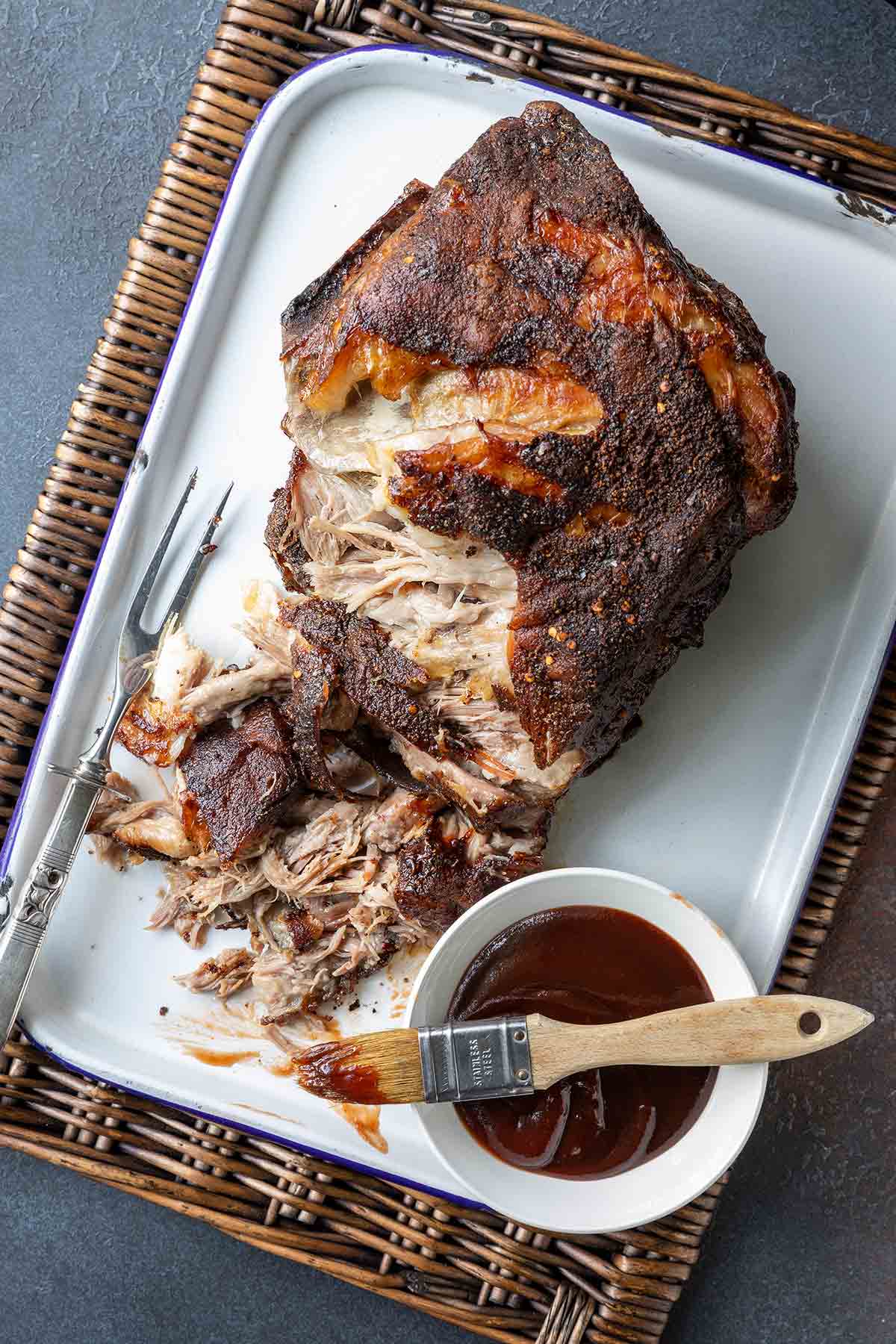
This post was updated Jan 6, 2025 to include a video, more serving suggestions, tips, and answers to more questions.
Over the past decade, I think of this recipe for oven-roasted pork butt as a masterclass in low-and-slow cooking. Adapted from Nick Evans, it combines a bold spice rub with the magic of slow roasting to create fork-tender, flavor-packed meat. After extensive testing in our testers’ kitchens, I’ve continued to fine-tune the recipe to give you consistent, foolproof results. Whether served as a centerpiece or shredded into sandwiches, this recipe delivers every time.
Jump To
- What’s the Difference Between Pork Butt and Pork Shoulder?
- Why This Recipe Works
- Notes on Ingredients
- How to Roast a Pork Butt
- Common Questions about Roasting Pork Butt
- Best Ways to Enjoy Pork Butt
- Pro Tips
- Storaging & Reheating
- More Juicy Pork Butt Recipes
- Write a Review
- How to Cook a Pork Butt in the Oven
- Roast Pork Butt Recipe
- Southwestern Rub Variation
- Recipe Testers’ Reviews
What’s the Difference Between Pork Butt and Pork Shoulder?
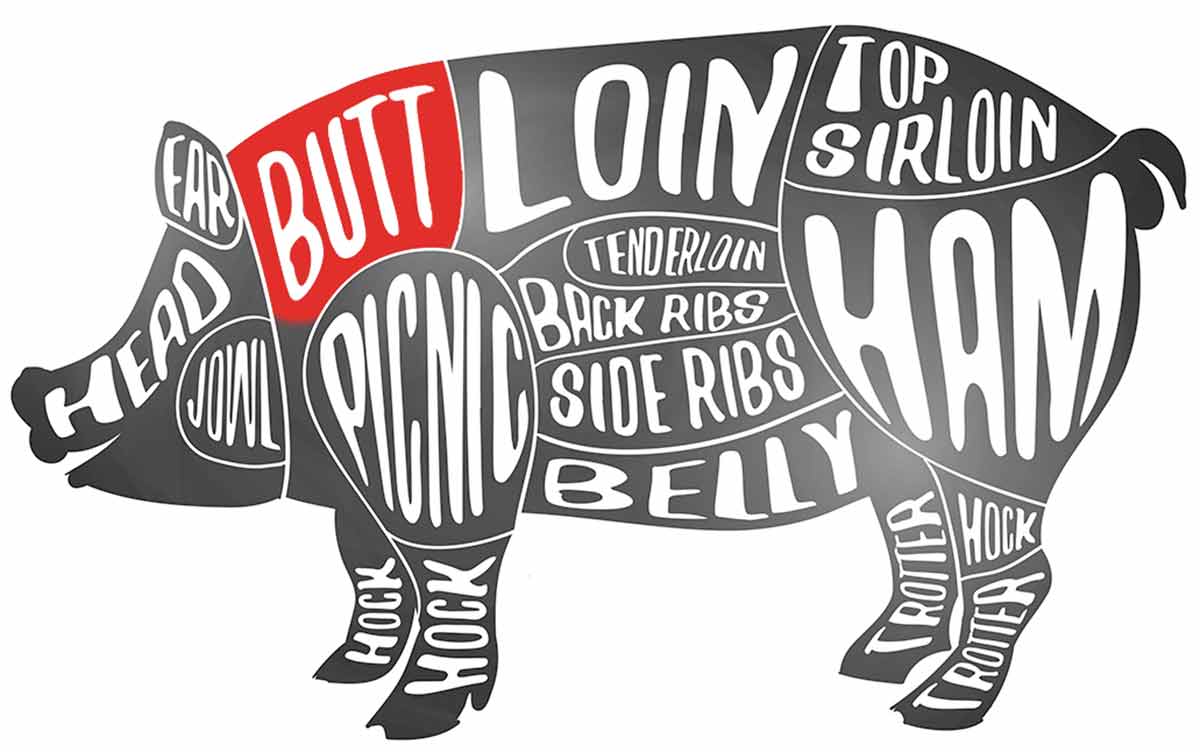
Pork butt isn’t actually the backend of the pig. That’s the ham. Pork butt is a squarish cut of meat that comes from the upper part of the pork shoulder of the pig and has lots of connective tissue and fat. It’s also known as Boston butt.
Now, pork shoulder (or picnic roast) is the lower, triangular portion of the shoulder and is more muscular.
Where things get confusing is many stores use the terms interchangeably. Luckily, both cuts work in this recipe.

Why This Recipe Works
This recipe delivers fall-apart tender, flavorful pork butt because of the low and slow cooking method that breaks down tough connective tissue. The balanced spice rub adds complexity, while the “fat cap up” technique ensures the meat bastes in its own juices for maximum moisture and flavor.
Resting the roast allows the juices to redistribute, guaranteeing a tender final product. Basically, it’s a foolproof method for delicious, melt-in-your-mouth pulled pork!
Notes on Ingredients
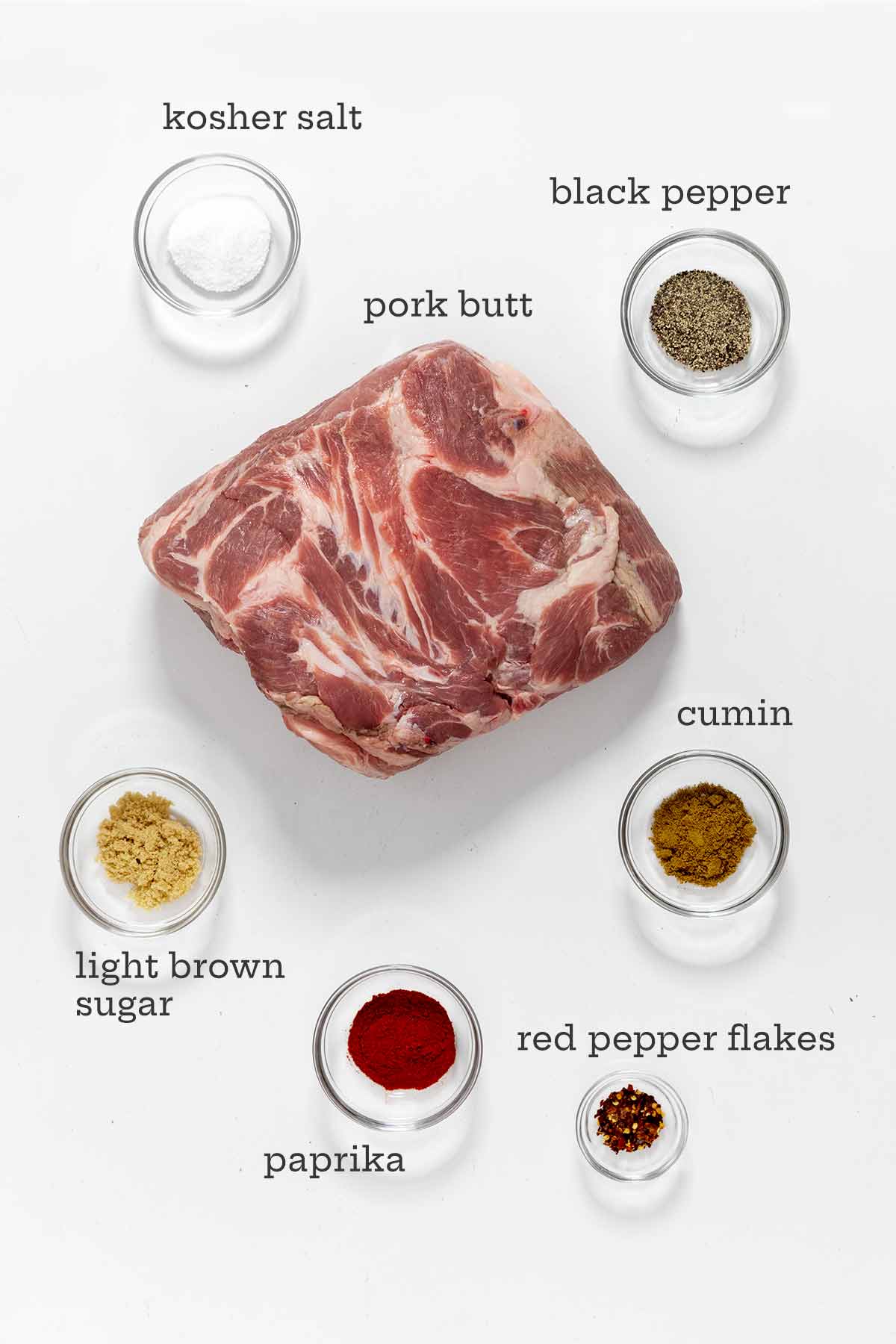
- Pork butt–Use a well-marbled cut of pork butt or Boston butt for best results. If your pork comes with the skin on, have your butcher remove it for you.
- Spice blend—Our blend includes brown sugar, paprika, cumin, red pepper flakes, salt, and pepper, creating a sweet, warm, slightly spicy flavor profile.
- Diamond brand kosher salt—Since salt’s weight varies from brand to brand, please weigh your salt and use 9 grams for this recipe. If you don’t have a scale and aren’t using Diamond brand, use 2 teaspoons to avoid oversalting.
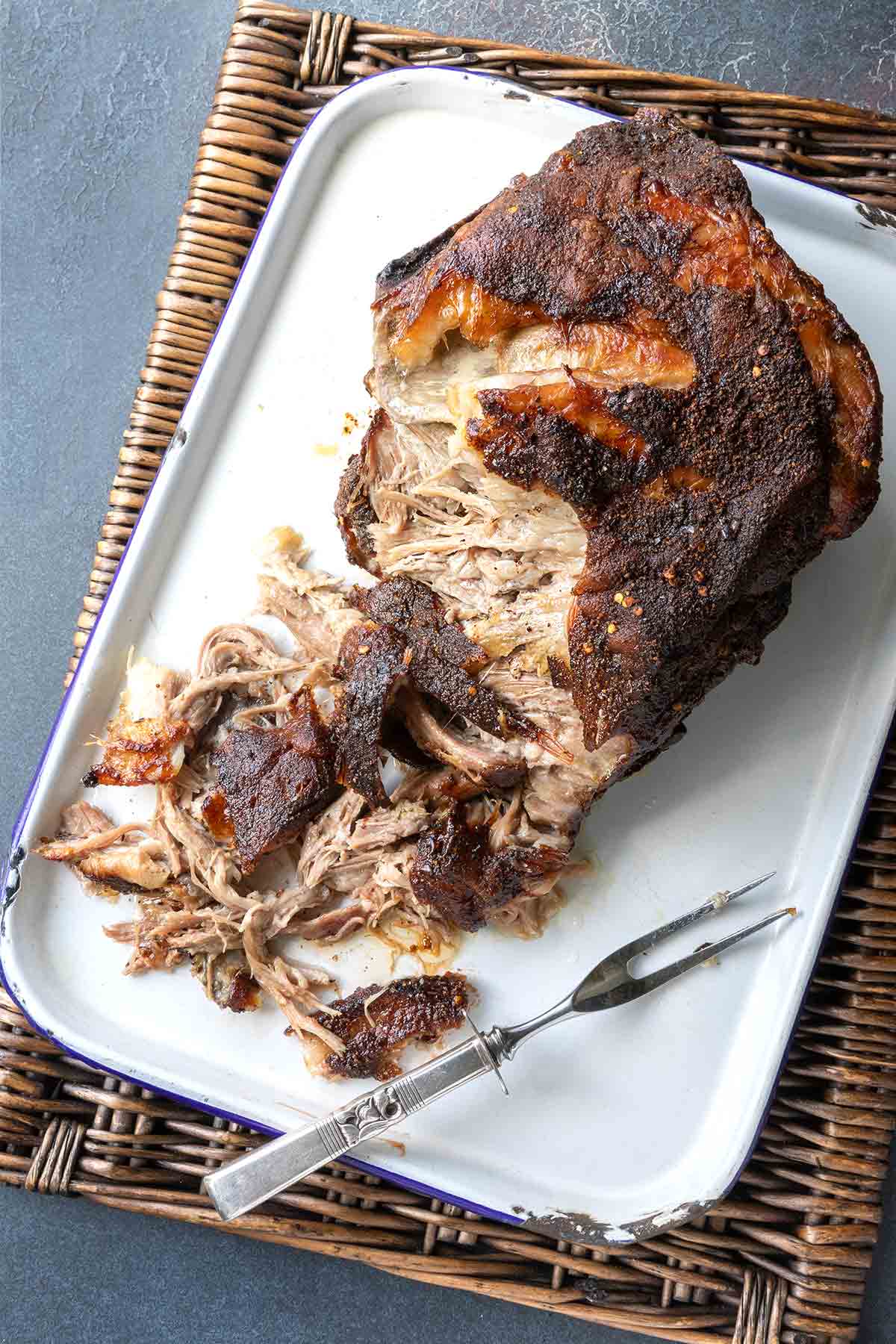
How to Roast a Pork Butt
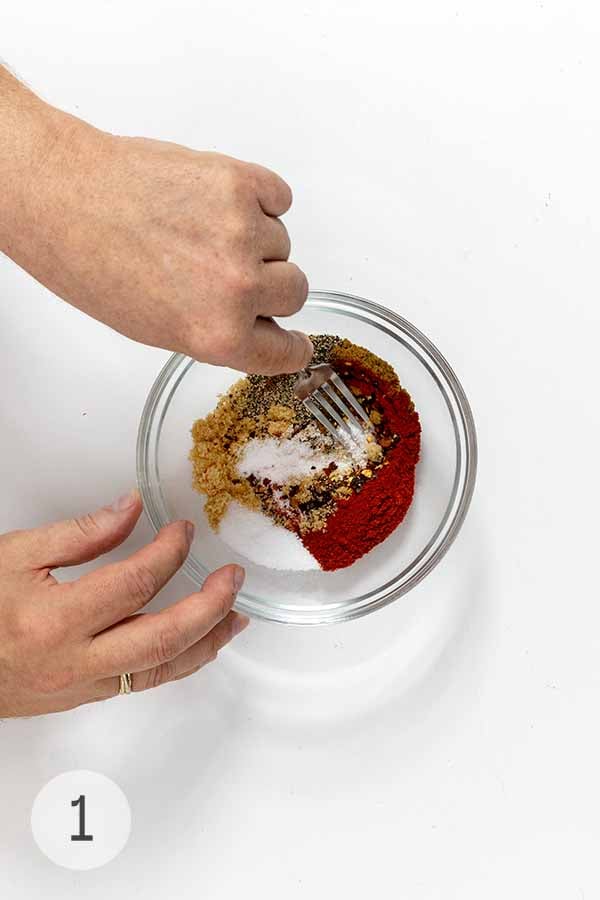
- Stir together the salt, sugar, paprika, pepper flakes, cumin, and black pepper in a small bowl.
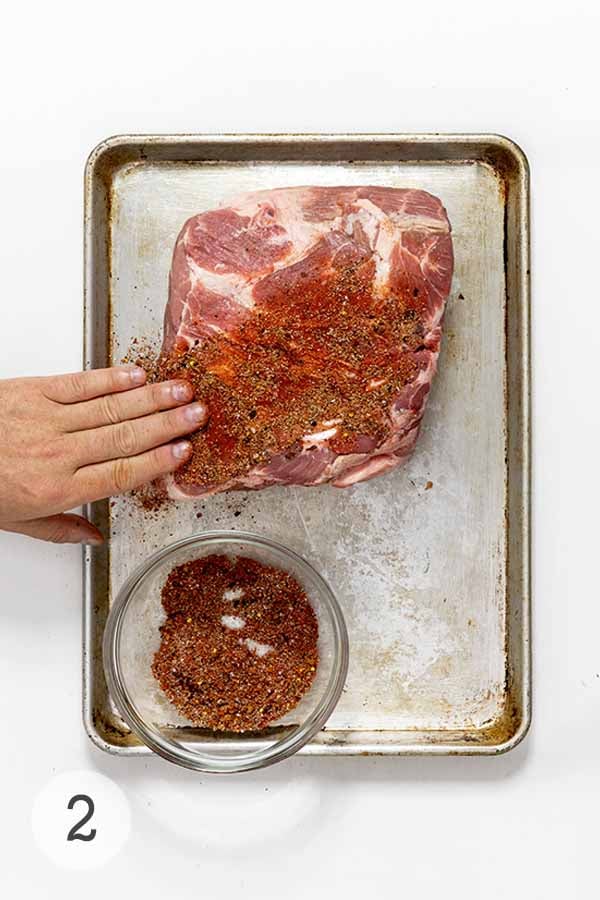
- Rub the pork all over with the spice mixture. It should be coated on all sides.
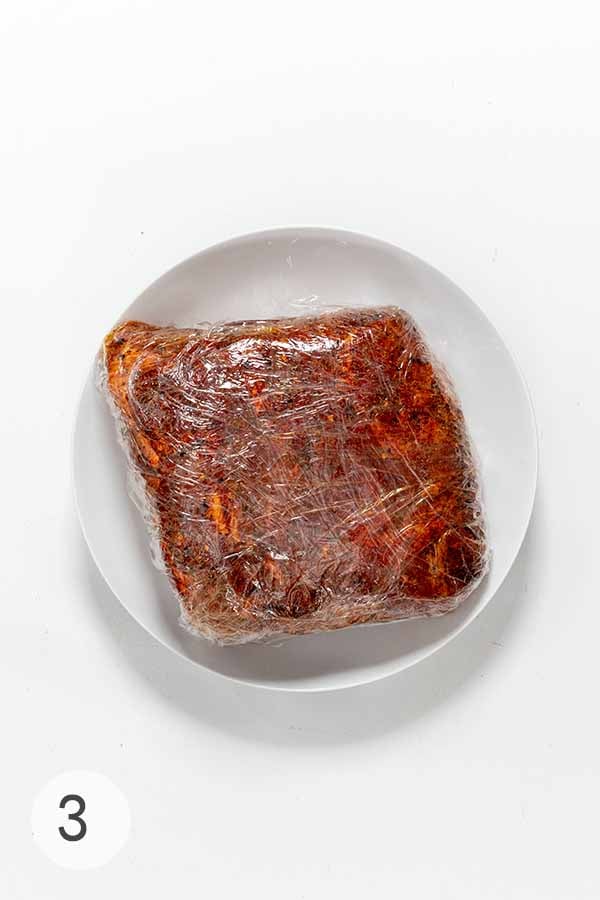
- Wrap the pork in plastic and refrigerate overnight.
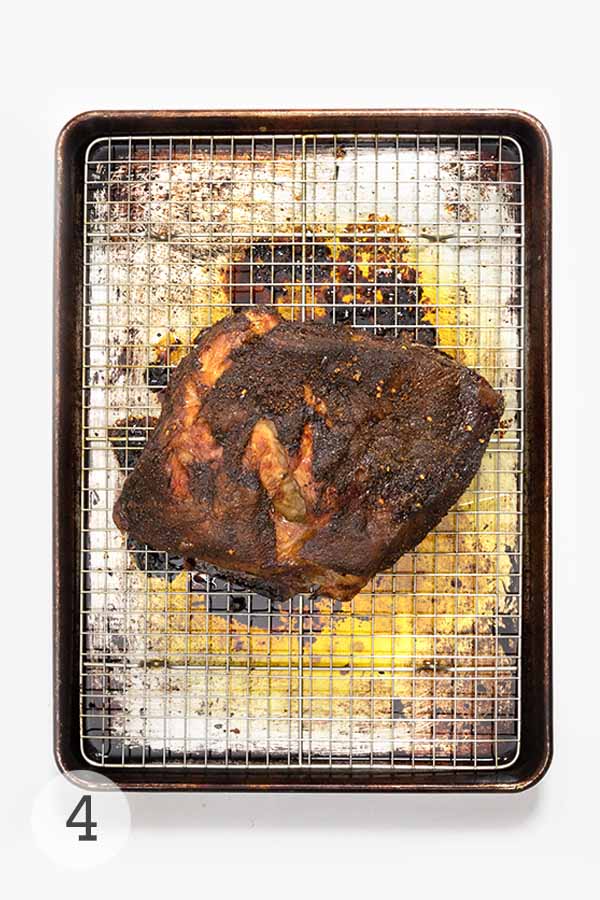
- Roast the pork, fatty side up, on a roasting pan in the oven until the internal temperature reaches 190° to 195°F. Let it rest at room temperature for 15 minutes.
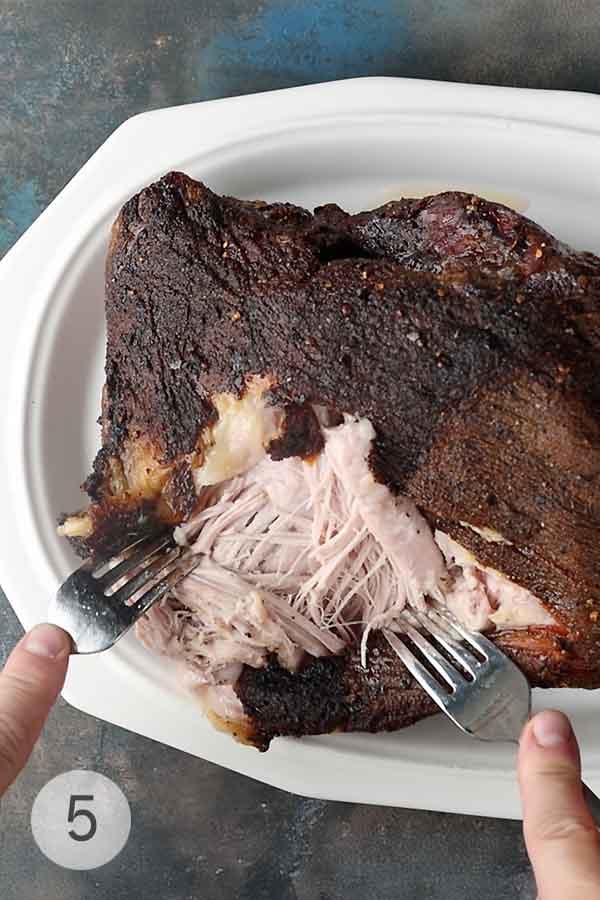
- Use two forks to shred the pork. Serve alone or with your favorite BBQ sauce, if desired.
Common Questions about Roasting Pork Butt
1. How long to cook pork butt in oven?
Cook pork butt at 250°F (121°C) for about 1 hour per pound until the internal temperature reaches 190°F to 195°F (88°C to 91°C). So a 6 1/2-to-8-pound pork butt would take between 6 to 8 hours, longer if the meat was particularly, which is why a thermometer is crucial.
2. Do I really need to use a meat thermometer for this recipe?
Totally. This pork recipe is almost impossible to pull off without a meat thermometer. You can’t judge the pork by sight or feel. I prefer a digital probe thermometer that can be left in the pork as it roasts. When you insert the thermometer, stick it into the thickest part of the pork butt, and make sure it’s not touching the bone, or you’ll get a false reading.
3. Do I need to let pork butt rest after cooking?
Yes! Resting the meat for at least 15 to 30 minutes allows the juices to redistribute, ensuring a tender and flavorful result.
4. Can I cook pork butt in a slow cooker instead of the oven?
Yes! Cook on low for 8 to 10 hours or high for 5 to 6 hours until it’s tender and falls apart easily.
Best Ways to Enjoy Pork Butt
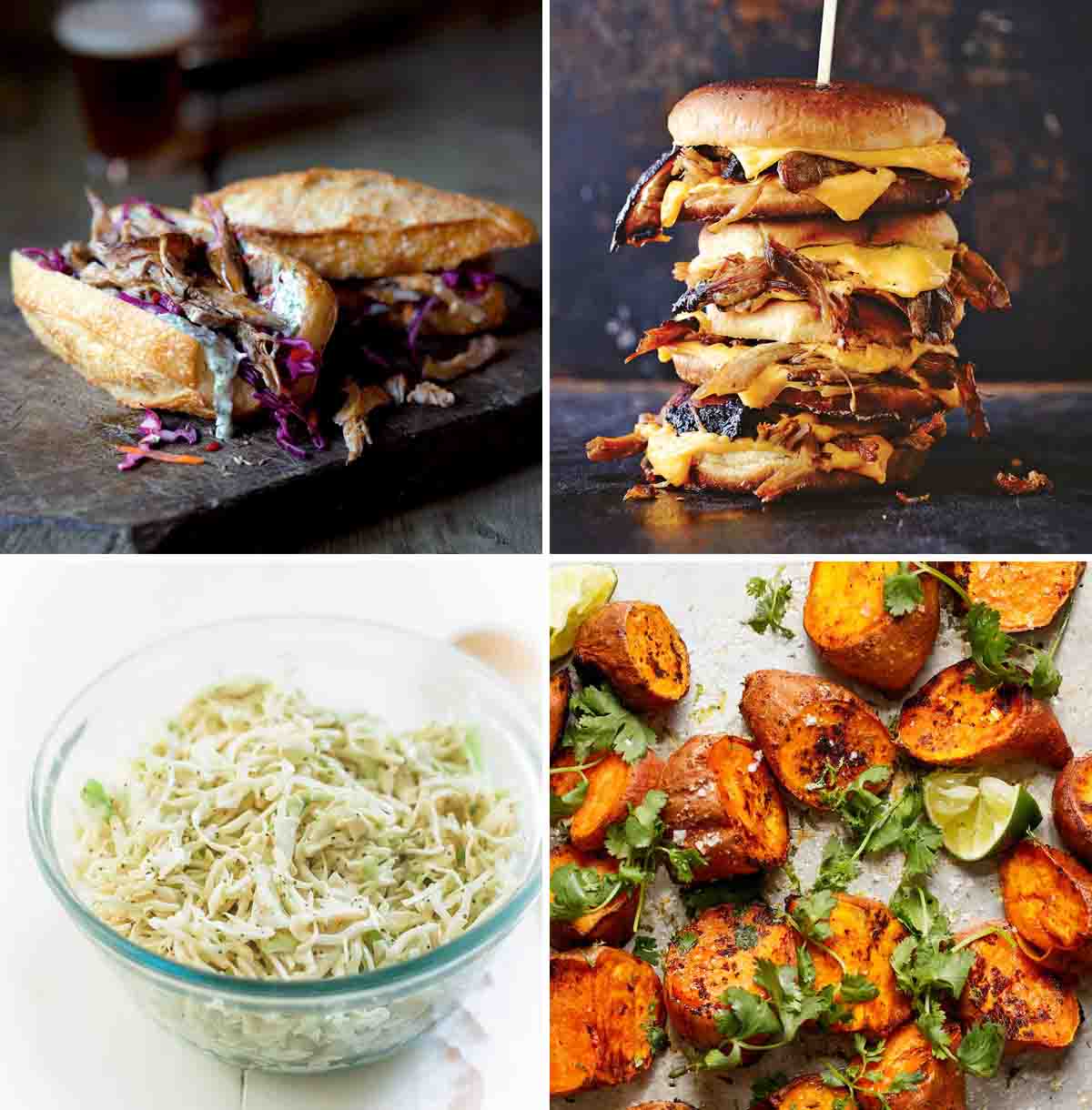
This pork butt recipe is stupendously magnificent on its own, butt (get it?!), consider:
- Serving it shredded on buns for pulled pork sandwiches topped with maple coleslaw.
- Slapping on some cheese for awesome pulled pork grilled cheese
- Serving it as a main dish with sweet potatoes with lime and hot sauce.
- Dousing it with a vinegary barbecue sauce.
- Heaping it upon homemade buns for pulled pork sandwiches.
- Dolloping a tablespoon or three of creamy coleslaw beneath the top bun.
- Stuffing it into burritos with black or refried beans, guacamole, sour cream, shredded pepper Jack, pico de gallo, and chopped cilantro; and then stuff it in your mouth!
- Sliding it into pork tacos
Pro Tips
- Letting the pork sit overnight after rubbing it with the spice mixture is optional but highly recommended.
- Make sure to let the pork butt rest before shredding it. It will be hot!
- The pulled pork can be stored well in the fridge in an airtight container for up to 4 days. If you’re freezing it for later, divvy it into 1-pound servings and freeze it in storage bags for up to 3 months. Reheat in a 300°F oven until warmed through.
- This recipe is suitable for gluten-free and dairy-free diets.
Storaging & Reheating
Pulled pork stores well in the fridge in an airtight container for up to 4 days. If you’re freezing it for later, divvy it into 1-pound servings and freeze it in storage bags for up to 3 months. Reheat in a 300°F oven until warmed through.
Write a Review
If you make this recipe, or any dish on LC, consider leaving a review, a star rating, and your best photo in the comments below. I love hearing from you.–David
I made this pork shoulder a month ago, and my whole family loved it! Now that my nephew’s in town, and because we all had it on our minds, I decided to make it again. I almost cried when I thought I lost the recipe! Thank you so much for sharing!
Melissa
How to Cook a Pork Butt in the Oven
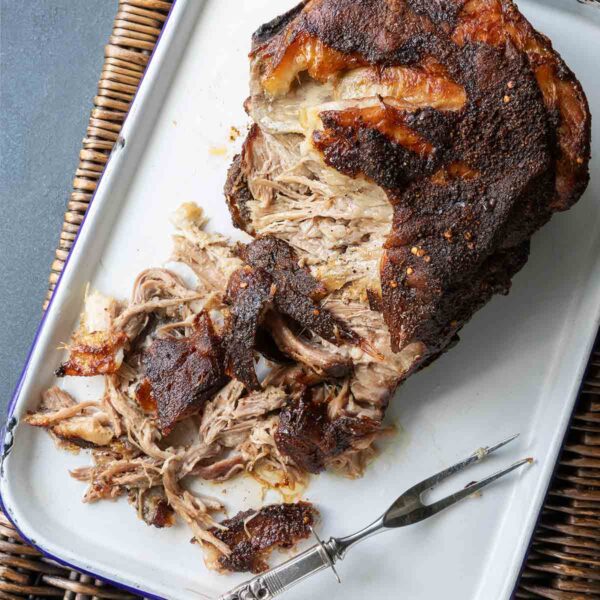
Roast Pork Butt
Equipment
Ingredients
- 1 tablespoon Diamond kosher salt
- 1 tablespoons light brown sugar
- 1 tablespoon paprika
- ½ to 1 tablespoon red pepper flakes
- 1 tablespoon ground cumin
- 1 tablespoon coarsely ground black pepper
- one (6 1/2- to 8-pound) bone-in skinless pork butt, or pork shoulder or two 3 1/2- to 4-pound pork butts
- Your favorite grocery store or homemade BBQ sauce, (optional)
Instructions
- In a small bowl, stir together the 1 tablespoon Diamond kosher salt, 1 tablespoons light brown sugar, 1 tablespoon paprika, ½ to 1 tablespoon red pepper flakes, 1 tablespoon ground cumin, and 1 tablespoon coarsely ground black pepper.
- Rub the one (6 1/2- to 8-pound) bone-in skinless pork butt all over with the spice mixture. The pork butt should be completely coated on all sides.
- If you have time, tightly wrap the pork in plastic wrap, place it on a plate, and refrigerate overnight (8 to 12 hours) to let the flavors "hold hands," as my grandmother used to say.
- Crank the oven temperature to 250°F (121°C). Place a roasting rack in a large pan.
- Place the pork butt, fat cap side up, on the rack. Roast the pork, uncovered, until the internal temperature reaches 190° to 195°F (88° to 91°C).By this point, the exterior should be crispy and dry. This is similar to what’s referred to as “bark” when smoking on a grill. This can take anywhere from 4 to 10 hours, depending on your oven and the size of your pork butt.
- Remove the pork from the oven and let the roast rest for 15 minutes on a cutting board.
☞ TESTER TIP: If you’re craving super-moist meat for pulled pork, remove the pan from the oven, tightly wrap the pork butt in a couple of layers of heavy-duty aluminum foil, and let it rest for 30 to 45 minutes to soften the exterior.
- Shred the roast pork butt with a couple of forks, evenly mixing the crisp, dry edges with the insanely moist, tender pork inside.
☞ TESTER TIP: You may want to slather the pulled pork with barbecue sauce to impart flavor and sauciness, but I urge you to try it naked first.
Notes
- Rest—Letting the pork sit overnight after rubbing it with the spice mixture is optional but highly recommended.
- Cool—Make sure to let the pork butt sit before shredding it. It will be hot.
- Storage—The pulled pork will store well in the fridge for up to 4 days. If you’re freezing it for later, divvy it into 1-pound servings and freeze it in storage bags. Reheat in a 300°F oven until warmed through.
- Dietary—This recipe works for gluten-free and dairy-free diet.
Southwestern Rub Variation
For a Southwestern vibe, mix these together and use in place of the rub above:- 2 tablespoons chili powder
- 1 tablespoon smoked paprika
- 1 tablespoon ground cumin
- 1 tablespoon dried oregano
- 1 teaspoon garlic powder
- 1 teaspoon onion powder
- 1 teaspoon cayenne pepper
- 1/2 teaspoon chipotle powder
- 1 tablespoon light brown sugar
- 2 teaspoons kosher salt
- 1 teaspoon black pepper

Nutrition
Nutrition information is automatically calculated, so should only be used as an approximation.
Recipe Testers’ Reviews
This is one of the best pork butt recipes. Excellent. I rubbed the blend on and then refrigerated the pork shoulder roast overnight so the flavors would meld.
The hands-on time is minimal—about 15 minutes to assemble the spice mixture and rub it all over the pork butt. I used about 1/2 the stated amount of red pepper flakes because I thought 1 tablespoon would give too much heat for my taste. I used a bone-in pork shoulder roast that was four pounds, and it took 6 hours in a convection oven set to 225°F.
I served the pork with the classic coleslaw recipe and a bit of Bobby Flay’s barbecue sauce on a soft roll. The pork definitely needs some kind of sauce.
Sometimes we either don’t have access to a smoker or can’t commit 6 or 8 hours to low and slow cooking on a grill. And while slow cookers can make WONDERFUL slow cooker pulled pork, one thing will be missing, and for me, that’s an essential part of pulled pork—the BARK!
When you rub a piece of pork with a spice rub and cook it, low and slow, on a smoker, grill, or in an oven, after several hours, the rub mixes with the hot fat and juices and eventually gets a hard crust called a BARK.
For my money, this is the VERY best part of ANY barbecue! Anyone who loves meat must LOVE a crisp, spice-rubbed exterior.) This bark can be achieved in your oven, and–as long as you have a clock and a thermometer–you can create a nice crust on your pork butt with this recipe. The rub mentioned here is great, but if you have your favorite rub on hand, by all means, use it.
From here, shred the roast pork butt by any means necessary (two forks work nicely) and top it with your favorite sauce, coleslaw, or, as I do, both.

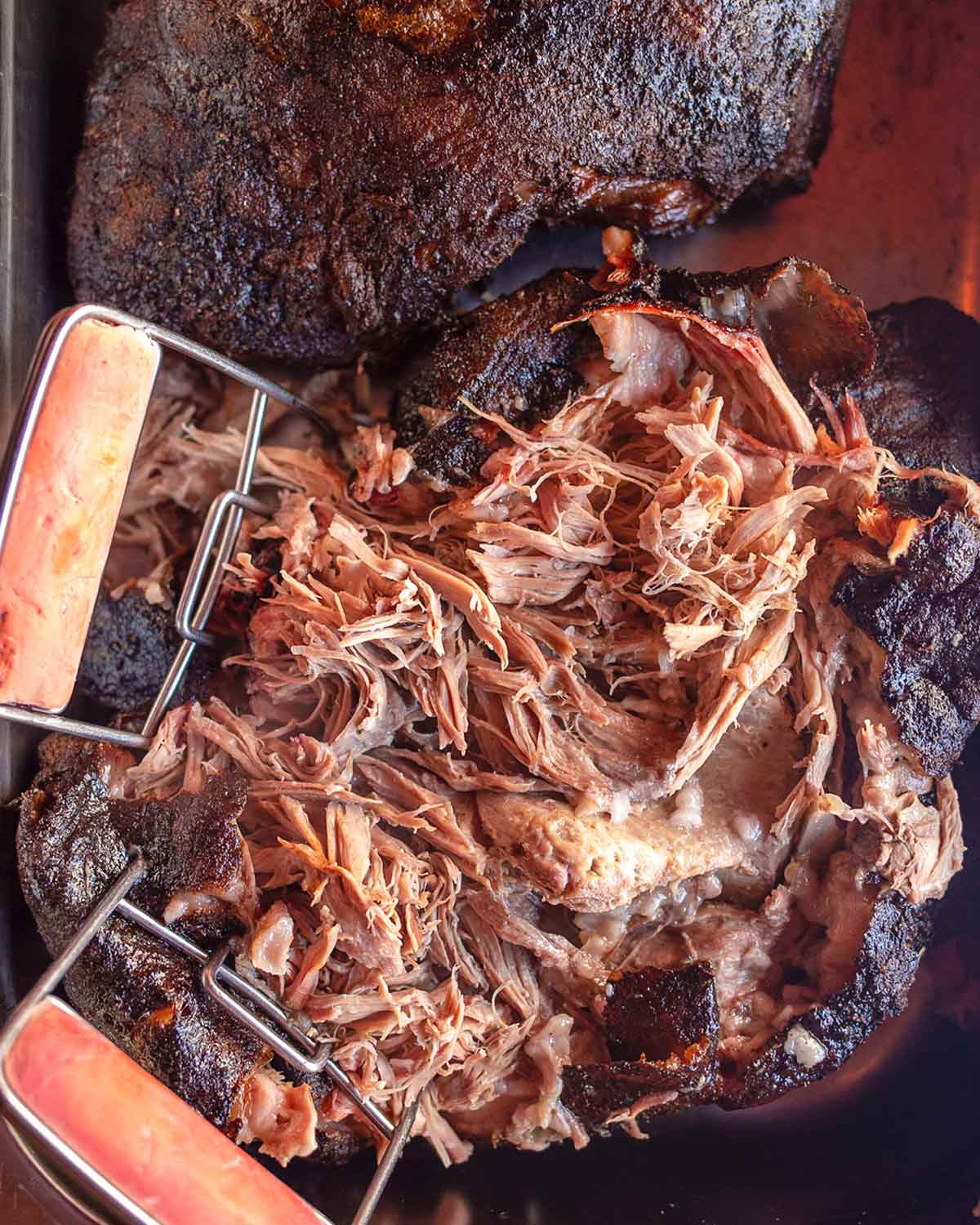
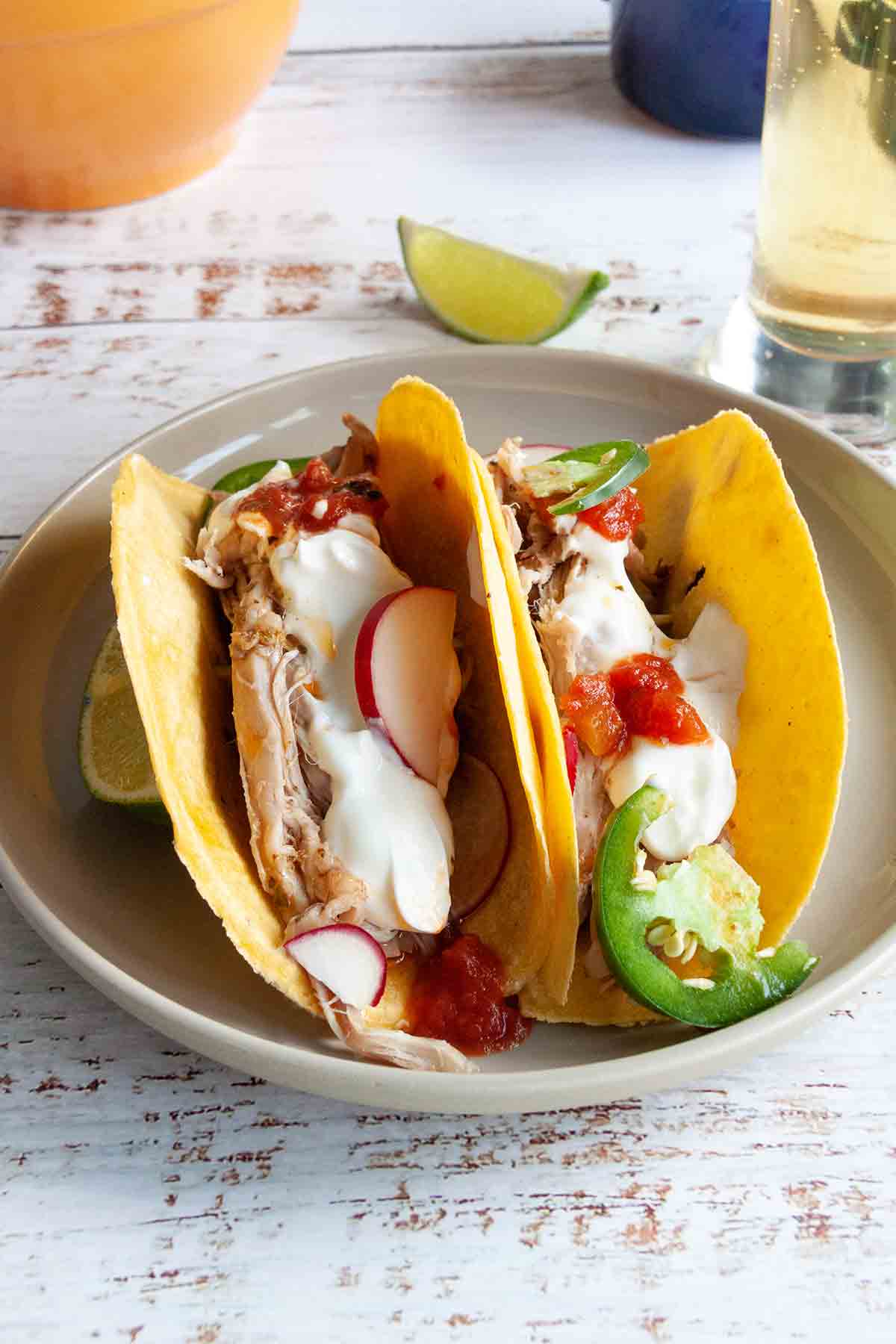












David, thank you for this recipe! I roasted in the oven 225 convection for a total of 8 hours. PERFECTION! My husband loved it so much that he went out today and bought another roast to have in the future! I served it with roasted potatoes and steamed broccoli. Great wine, also. Thank you so much, again and again!
Christine, you are MORE than welcome. I’m so happy that it turned out well.
My pork is boneless and is all tied up! Should l leave it tied??? Thank you? I love your rub recipe!!!
You can leave the roast tied and then just cut away the string before you wrap it in foil, Karen.
This was superb. At the last minute I found myself at Whole Foods early on Easter Sunday morning and bought the last Boston Butt in the case. I cooked it for 6 1/2 hours at 225 convection (no time for overnight marinade). The roast came with the elasticized net to hold it together. I didn’t know whether to leave it on or take it off before cooking. Decided to leave it on. It was a little hard to remove for serving but once off it left a beautiful crosshatch in the bark. Really outstanding and aside from my anxiety about not having started it the day before it was a simple, painless recipe with abundant rewards.
I’m so pleased to hear this, Deb! It sounds like you had a fantastic meal. Thanks so much for taking the time to comment.